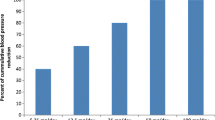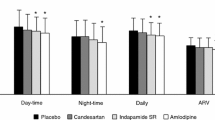Summary
There are a number of clinically relevant differences between torasemide and the thiazide diuretics in the treatment of hypertension. Only 2.5–5 mg torasemide once daily is sufficient for antihypertensive treatment; these low doses of torasemide exert comparable antihypertensive effects to those of the overtly natriuretic doses of thiazides (e.g., hydrochlorothiazide 25 mg) that are currently used once daily for the treatment of hypertension. Whereas natriuretic thiazide doses reduce blood pressure rapidly, the blood pressure-lowering effect of low-dose torasemide appears to occur more gradually during the first weeks of treatment. The diurnal blood pressure rhythm is not altered by either drug. In contrast to the thiazides, torasemide does not cause significant renal potassium loss in doses recommended to treat hypertension. Long-term antihypertensive treatment with torasemide has not resulted in undesired metabolic side effects, such as hypomagnesemia, alterations in glucose and lipid metabolism, or hyperuricemia. As compared with the thiazides, torasemide appears to be a safer and equally effective alternative for antihypertensive treatment when subdiuretic doses of this loop diuretic are used.
Similar content being viewed by others
References
Freis ED. Critique of the clinical importance of diuretic-induced hypokalemia and elevated cholesterol level.Arch Intern Med 1988;149:2640–2648.
Reyes AJ, Leary WP, van der Byl K. Excretions of urinary fluid and solutes after single doses of furosemide and hydrochlorothiazide and of four different single doses of the diuretic torasemide in healthy subjects.Prog Pharmacol Clin Pharmacol 1990;8(1):47–71.
McMahon FG.Management of essential hypertension: The once-a-day era. 1990:297–378.
Magee PFA, Freis ED. Is low-dose hydrochlorothiazide effective?Hypertension 1986;8:135–139.
Carlson JE, Kober L, Torp-Peterson C, Johansen P. Relation between dose of bendrofluazide, antihypertensive effect and adverse biochemical effects.Br Med J 1990;300:975–978.
Freis ED, Thomas JR, Fisher SG, et al. Effects of reduction in drugs or dosage after long-term control of systemic hypertension.Am J Cardiol 1989;63:702–708.
Hollifield JW. Thiazide treatment of hypertension. Effects of thiazide diuretics on serum potassium, magnesium and ventricular ectopy.Am J Med 1986;80(Suppl 4A):8–12.
Khatri I, Materson BJ, Freis ED, et al. Blood pressure response to low and high-dose thiazide diuretic for the isolated systolic hypertension of the elderly (abstract).Hypertension 1987;10:370.
Kohvakka A, Salo H, Gordin A, et al. Antihypertensive and biochemical effects of different doses of hydrochlorothiazide alone or in combination with triamterene.Acta Med Scand 1986;219:381–386.
Kochar MS, Landry KM, Ristow SM. Effects of reduction in dose and discontinuation of hydrochlorothiazide in patients with controlled essential hypertension.Arch Intern Med 1990;150:1009–1011.
Dupont AG, Schoors D, Six RO, et al. Antihypertensive efficacy of low dose torasemide in essential hypertension: A placebo-controlled study.J Human Hypertens 1988;2:265–268.
Achhammer I, Metz P. Low dose loop diuretics in essential hypertension. Experience with torasemide.Drugs 1991;41(Suppl 3):80–91.
Porcellati C, Verdecchia P, Schillaci G et al. La torasemide, nuovo diuretico del'ansa, nel tratamento dell'ipertensione arteriosa. Studio controllato in doppia cecità.Basi Razion Ter 1990;20:407–410.
Baumgart P, Walger P, v. Eiff M, et al. Long-term efficacy and tolerance of torasemide in hypertension.Prog Pharmacol Clin Pharmacol 1990;8(1):169–181.
Reyes AJ, Chiesa PD, Santucci MR, et al. Hydrochlorothiazide versus a non-diuretic dose of torasemide as once-daily antihypertensive monopharmacotherapy in elderly patients. A randomized and double-blind study.Prog Pharmacol Clin Pharmacol 1990;8(1):183–209.
Spannbrucker N, Achhammer I, Metz P, et al. Comparative study on the antihypertensive efficacy of torasemide and indapamide in patients with essential hypertension.Arzneim Forsch/Drug Res 1988;38(I):190–193.
Achhammer I, Eberhard R. Comparison of serum potassium levels during long-term treatment of hypertensive patients with 2.5 mg torasemide/day or 50 mg triameterene/25 mg hydrochlorothiazide/day.Prog Pharmacol Clin Pharmacol 1990;8(1):211–220.
Boelke T, Achhammer I, Meyer-Sabellek WA, et al. Tages-und Nachrthythmik ambulanter 24-h Blutdruckwerte von älteren essentiellen Hypertonikern bei Therapie mit verschiedenen Antihypertonika.Hochdruck 1990;10:40.
Boelke T, Achhammer I, Meyer-Sabellek WA. Blutdrucksenkung und metabolische Veränderungen bei essentiellen Hypertonikern nach Langzeitgabe unterschiedlicher Diuretika.Hochdruck 1990;9:40–41.
Lacourcière Y, Provencher P. Comparative effects of zofenopril and hydrochlorothiazide on office and ambulatory blood pressures in mild-to-moderate essential hypertension.Br J Clin Pharmacol 1989;27:371–376.
Carrageta O, Soares R, Martins A. The 24-hour ambulatory profile of blood pressure reduction with muzolimine.Clin Nephrol 1983;29(Suppl 1):114–115.
Reyes AJ, Leary WP, Alcocer L. The antihypertensive effect of diuretics: Overview and formal evaluation by the Montevideo Mathematical Model.Prog Pharmacol 1988;6(3):193–243.
Messerli FH. Antihypertensive therapy—is it different in the elderly?Drugs 1990;39(Suppl 2):49–54.
Peters RW, Hamilton J, Hamilton BP. Incidence of cardiac arrhythmias associated with mild hypokalemia induced by low-dose diuretic therapy for hypertension.South Med J 1989;82:966–969.
Waite WW, Wade WE, Cobb HH. Effect of diuretic regimens on serum potassium.Can J Hosp Pharm 1988;41:243–247.
Morgan DB, Davidson C. Hypokalemia and diuretics. An analysis of publications.Br Med J 1980;905–908.
Ames RP. The influence of non-beta-blocking drugs on the lipid profile: Are diuretics outclassed as initial therapy for hypertension?Am Heart J 1987;114:998–1006.
Morgan TO. Metabolic effects of various antihypertensive agents.J Cardiovasc Pharmacol 1990;15(Suppl 5):39–45.
Goldman AI, Steele BW, Schnaper HW, et al. Serum lipoprotein levels during chlorthalidone therapy.JAMA 1980;224:1691–1695.
Lardinois CIK, Neumann SHL. The effects of antihypertensive agents on serum lipids and lipoproteins.Arch Intern Med 1988;148:1280–1288.
Author information
Authors and Affiliations
Rights and permissions
About this article
Cite this article
Baumgart, P. Torasemide in comparison with thiazides in the treatment of hypertension. Cardiovasc Drug Ther 7 (Suppl 1), 63–68 (1993). https://doi.org/10.1007/BF00877959
Issue Date:
DOI: https://doi.org/10.1007/BF00877959




